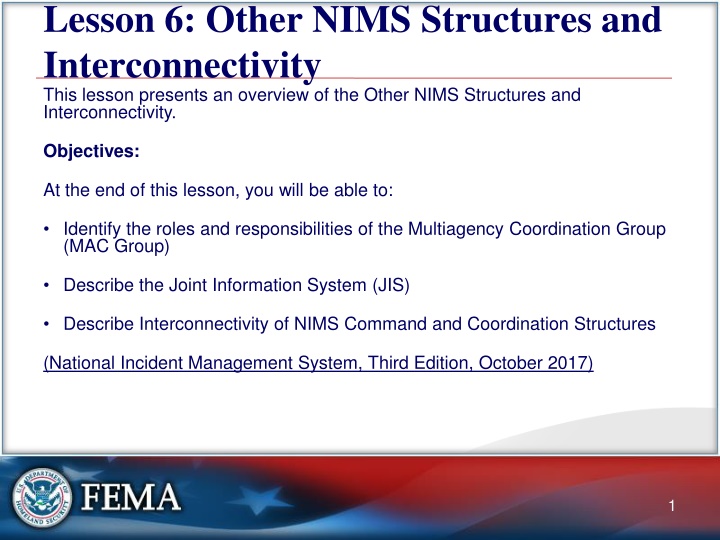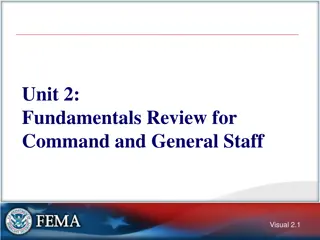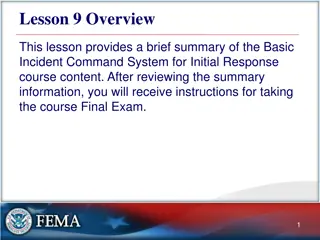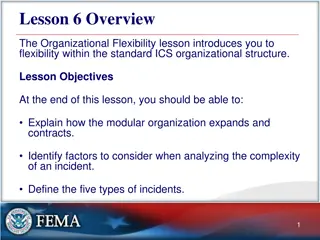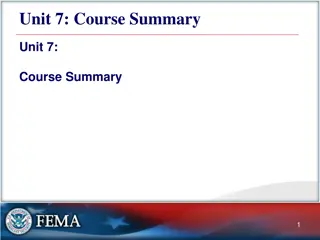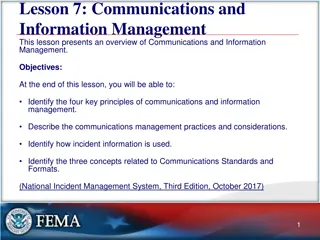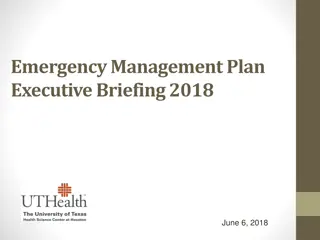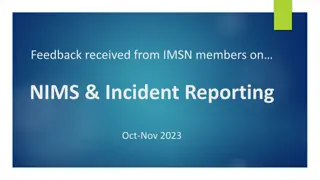Other NIMS Structures and Interconnectivity Overview
This lesson covers the Multiagency Coordination Group, Joint Information System, and interconnectivity within NIMS structures. Learn about MAC Groups, roles of elected and appointed officials, and more.
Download Presentation

Please find below an Image/Link to download the presentation.
The content on the website is provided AS IS for your information and personal use only. It may not be sold, licensed, or shared on other websites without obtaining consent from the author.If you encounter any issues during the download, it is possible that the publisher has removed the file from their server.
You are allowed to download the files provided on this website for personal or commercial use, subject to the condition that they are used lawfully. All files are the property of their respective owners.
The content on the website is provided AS IS for your information and personal use only. It may not be sold, licensed, or shared on other websites without obtaining consent from the author.
E N D
Presentation Transcript
Lesson 6: Other NIMS Structures and Interconnectivity This lesson presents an overview of the Other NIMS Structures and Interconnectivity. Objectives: At the end of this lesson, you will be able to: Identify the roles and responsibilities of the Multiagency Coordination Group (MAC Group) Describe the Joint Information System (JIS) Describe Interconnectivity of NIMS Command and Coordination Structures (National Incident Management System, Third Edition, October 2017) 1
Other NIMS Structures and Interconnectivity Introduction The Incident Command System (ICS) and Emergency Operations Centers (EOC), which were discussed in the prior lessons of this course, are two of the four NIMS Command and Coordination structures. In this lesson, we will learn about Multiagency Coordination (MAC) Groups and the Joint Information System (JIS), and discuss the interconnectivity between the NIMS Command and Coordination structures. 2
MAC Group Definition and Composition Multiagency Coordination Groups (MAC Group) are part of the off-site incident management structure of NIMS. MAC Groups are also sometimes referred to as policy groups. MAC Group members are typically agency administrators, executives or their designees from stakeholder agencies or organizations impacted by and with resources committed to the incident. The MAC Group may also include representatives from non-governmental organizations such as businesses and volunteer organizations. During incidents, MAC Groups: Act as a policy-level body Support resource prioritization and allocation Make cooperative multi-agency decisions Enable decision making among elected and appointed officials and the Incident Commander responsible for managing the incident. The MAC Group does not perform incident command functions, nor does it replace the primary functions of EOCs or other operations, coordination, or dispatch organizations. 3
Discussion Question What are some examples of how a MAC Group or policy group can help during an incident? 4
Elected and Appointed Officials Elected and appointed officials such as governors, tribal leaders, mayors, city managers and county commissioners are key players in incident management because they are responsible for: The safety and welfare of their constituents The overall effectiveness of incident management efforts within their jurisdiction Elected and appointed officials operate at the policy level of incident management. The MAC Group provides a way for these policy-level officials to work together, enhancing unity of effort at the senior level. 5
Voices of Experience: Elected and Appointed Officials Steve Grainer, Former Chief, Incident Management Programs, VA Dept. of Fire Programs "Our elected and senior appointed officials have first a moral obligation to do whatever is possible to provide for the well-being, the welfare if you will, of the citizens that elected them and entrusted them with their well- being. On that count my feeling is that elected officials should at a minimum be familiar enough with the core reasoning behind NIMS and the primary components of NIMS, the concepts on which NIMS is built." 6
Voices of Experience: Elected and Appointed Officials Curry Mayer, Former Training & Exercise Chief, Governor s Office of Emergency Services (CA) "NIMS has let people know that everyone who is responsible for public welfare really should have at least an understanding of what the NIMS is about, what are the important pieces of it, what do you have to know to be able to plug into it, and how does it facilitate all of those levels of government working together. So I think the important piece is that appointed officials and our elected officials are those that, they really have two roles. One is that they are charged with protecting the public, and then from their point of view, how do they know that they will be able to do that, and NIMS provides a system that is workable anywhere in the country so that any government entity or any response agency that is needed can plug into the system. And there is the requirement that not only do you, are you aware of what the system is but that you practice it, that you have some training in it so you re not only, so it s not just a check the box but that you are actually able to perform a role in the system and ensure that the public is secured for in a large event." 7
Joint Information System (JIS) Purpose The Joint Information System (JIS) is the fourth NIMS Command and Coordination structure. JIS integrates incident information and public affairs into a unified organization that provides consistent, coordinated, accurate, accessible, timely and complete information to the public and stakeholders during incident operations. JIS operates across and supports the other NIMS Command and Coordination structures: ICS, EOC and MAC Group. 8
JIS Description and Components: PIO and JIC The Public Information Officer (PIO) and Joint Information Center (JIC) are two supporting elements of the JIS. The PIO is a key member of ICS and EOC organizations, though they might go by a different title in EOCs. PIO functions include: Advising the Incident Commander, Unified Command or EOC director on public information matters Gathering, verifying, coordinating, and disseminating accurate, accessible, and timely information Handling inquiries from the media, public and elected officials Providing emergency public information and warnings Conducting rumor monitoring and response The JIC is a central location that houses JIS operations and where public information staff perform essential information and public affairs functions. Normally, an incident should have a single JIC, but the JIS is flexible and can accommodate multiple JICs if necessary. 9
JIS Description and Components: Information In some cases, lives will depend on getting information to the public quickly and those responsible take necessary steps to alert the public. Getting information to the public and stakeholders during an incident requires an ongoing information cycle: Gathering complete information for the public and other stakeholders Verifying information to ensure accuracy Coordinating information with other public information personnel who are part of the JIS to ensure consistency Disseminating consistent, coordinated, accurate, accessible, timely and complete information to the public and stakeholders 10
Public Information Communications Planning Well-developed and coordinated public information, education and communications plans enable the sharing of public safety information. This can include information such as lifesaving measures or evacuation routes. The information communications plan can include: Draft news releases Media lists Contact information for elected/appointed officials, community leaders, private sector organizations, and public service organizations Public information communications plans should be included in training and exercises in order to prepare for actual incidents. 11
Voices of Experience: Public Information 12
Discussion Question Why is it important that the JIS operates across and support the other NIMS Command and Coordination structures? Who would you include in your Joint Information System? What are the supporting elements of the JIS? 13
Interconnectivity of NIMS Command and Coordination Structures NIMS structures enable incident managers to manage incidents in a unified, consistent manner. Interconnectivity of NIMS structures is important to allow personnel in diverse geographic areas, with differing roles and responsibilities, and operating within various functions of ICS and/or EOCs to integrate their efforts through common organizational structures, terminology, and processes. 14
Interconnectivity of NIMS Command and Coordination Structures (Continued) When an incident occurs or threatens, local emergency personnel manage response using NIMS principles and ICS. If the incident is or becomes large or complex, local EOCs activate. EOCs receive senior level guidance from MAC Groups. A Joint Information Center (JIC) manages the Joint Information System (JIS) operations to ensure coordinated and accurate public messaging among all levels: ICS, EOC and MAC Group. NIMS structures enable incident managers to manage incidents in a unified, consistent manner. 15
Federal Support to Response Activities The Federal Government has a variety of capabilities and resources to support domestic incidents. Most incidents are resolved using capabilities available from the local jurisdiction. Larger incidents are resolved with support from by neighboring jurisdictions, or State, tribal, territorial, and interstate sources. The Federal Government only becomes involved with a response: When state governors or tribal leaders request Federal assistance and their requests are approved When Federal interests are involved As statute or regulation authorizes or requires In most cases the Federal Government plays a supporting role to state, tribal, or territorial governments by providing Federal assistance to the affected jurisdictions. For example, the Federal Government provides assistance under the Robert T. Stafford Disaster Relief and Emergency Assistance Act (Stafford Act) when the President declares an emergency or major disaster. In some cases, the Federal Government may play a leading role in response, such as when an incident occurs on Federal property or when the Federal Government has primary jurisdiction (such as in a terrorist attack or a major oil spill). 16
Federal Support to Response Activities The Federal Government has a variety of capabilities and resources to support domestic incidents. Most incidents are resolved using capabilities available from the local jurisdiction. Larger incidents are resolved with support from by neighboring jurisdictions, or State, tribal, territorial, and interstate sources. The Federal Government only becomes involved with a response: When state governors or tribal leaders request Federal assistance and their requests are approved When Federal interests are involved As statute or regulation authorizes or requires In most cases the Federal Government plays a supporting role to state, tribal, or territorial governments by providing Federal assistance to the affected jurisdictions. For example, the Federal Government provides assistance under the Robert T. Stafford Disaster Relief and Emergency Assistance Act (Stafford Act) when the President declares an emergency or major disaster. In some cases the Federal Government may play a leading role in response, such as when an incident occurs on Federal property or when the Federal Government has primary jurisdiction (such as in a terrorist attack or a major oil spill). 17
Discussion Question What are some examples of how the NIMS Command and Coordination Structures Interconnected? 18
Lesson 6: Other NIMS Structures and Interconnectivity Summary The lesson presented other NIMS Structures and Interconnectivity. The lesson specifically discussed the : Multiagency Coordination Group (MAC Group) Joint Information System (JIS) Interconnectivity of NIMS Command and Coordination Structures The next lesson will introduce you to Communications and Information Management. 19
